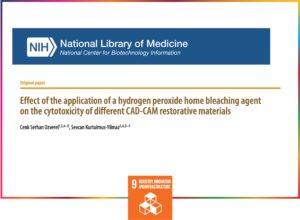
Researchers Özverel and Kurtulmuş from Faculty of Dentistry, Near East University conducted a study aiming to investigate the cytotoxic effects of different dental materials when exposed to over-the-counter bleaching agents commonly used at home. The study focused on lithium disilicate ceramic (LDC), resin nano-ceramic (RNC), and nano-hybrid composite (NHC) computer-aided design/computer-aided manufacturing (CAD-CAM) block materials. A total of 432 specimens were prepared and subjected to either phosphate-buffered saline (PBS) or artificial saliva, with or without exposure to a bleaching agent over a period of 15 days. The viability of epithelial cells was assessed using the 3-(4,5-dimethylthiazol-2-yl)-2,5-diphenyltetrazolium bromide (MTT) assay. Results indicated that all restorative materials led to decreased cell viability, with the highest cytotoxicity observed on the 15th day of the study. Specifically, the application of a bleaching agent intensified cytotoxicity in LDC specimens stored in artificial saliva, while RNC material exhibited higher cell viability compared to LDC and NHC groups when stored in PBS. However, no significant difference was observed between LDC and RNC specimens stored in artificial saliva.
Furthermore, NHC demonstrated the highest cytotoxicity when subjected to bleaching. The study concluded that over-the-counter home bleaching agents reduced cell viability, particularly in contact with LDC material, and this effect was time-dependent. Moreover, storage media and bleaching agents influenced the cytotoxic behavior of restorative materials, suggesting the need to inform patients about potential biological responses and recommending shorter periods of use to minimize cytotoxic effects.
This research provides valuable insights into the interaction between dental materials and bleaching agents, contributing to better understanding and management of their potential side effects in clinical practice.
More Information:
https://pubmed.ncbi.nlm.nih.gov/37273179/#full-view-affiliation-1